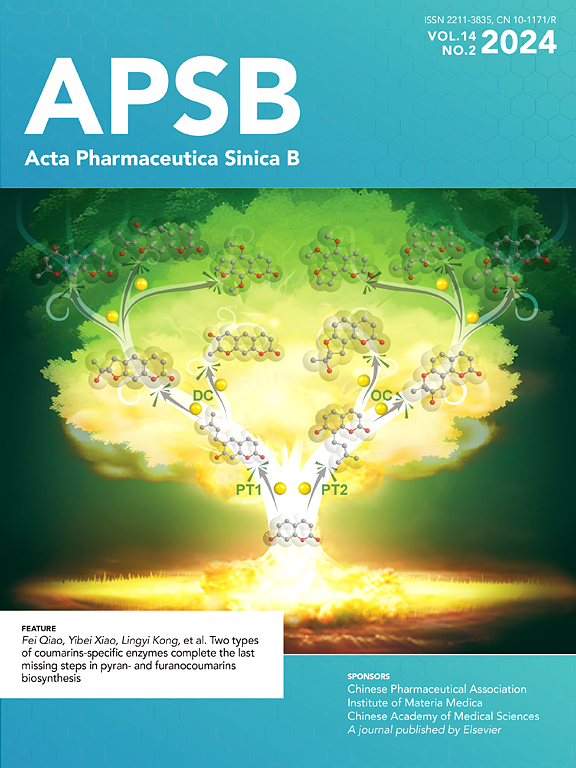Silencing PTPN2 with nanoparticle-delivered small interfering RNA remodels tumor microenvironment to sensitize immunotherapy in hepatocellular carcinoma
IF 14.6
1区 医学
Q1 PHARMACOLOGY & PHARMACY
引用次数: 0
Abstract
Protein tyrosine phosphatase nonreceptor type 2 (PTPN2) is a promising target for sensitizing solid tumors to immune checkpoint blockades. However, the highly polar active sites of PTPN2 hinder drug discovery efforts. Leveraging small interfering RNA (siRNA) technology, we developed a novel glutathione-responsive nano-platform HPssPT (HA/PEIss@siPtpn2) to silence PTPN2 and enhance immunotherapy efficacy in hepatocellular carcinoma (HCC). HPssPT showed potent transfection and favorable safety profiles. PTPN2 deficiency induced by HPssPT amplified the interferon γ signaling in HCC cells by increasing the phosphorylation of Janus-activated kinase 1 and signal transducer and activator of transcription 1, resulting in enhanced antigen presentation and T cell activation. The nano-platform was also able to promote the M1-like polarization of macrophages in vitro. The unique tropism of HPssPT towards tumor-associated macrophages, facilitated by hyaluronic acid coating and CD44 receptor targeting, allowed for simultaneous reprogramming of both tumor cells and tumor-associated macrophages, thereby synergistically reshaping tumor microenvironment to an immunostimulatory state. In HCC, colorectal cancer, and melanoma animal models, HPssPT monotherapy provoked robust antitumor immunity, thereby sensitizing tumors to PD-1 blockade, which provided new inspiration for siRNA-based drug discovery and tumor immunotherapy.

用纳米颗粒递送的小干扰RNA沉默PTPN2重塑肿瘤微环境,使肝癌免疫治疗增敏
蛋白酪氨酸磷酸酶非受体2型(PTPN2)是使实体肿瘤对免疫检查点阻断致敏的一个有希望的靶点。然而,PTPN2的高极性活性位点阻碍了药物的发现。利用小干扰RNA (siRNA)技术,我们开发了一种新的谷胱甘肽响应纳米平台HPssPT (HA/PEIss@siPtpn2),以沉默PTPN2并提高肝细胞癌(HCC)的免疫治疗效果。HPssPT表现出有效的转染和良好的安全性。HPssPT诱导的PTPN2缺陷通过增加janus活化激酶1和转录信号转换器和激活因子1的磷酸化,放大了HCC细胞中的干扰素γ信号,从而增强了抗原呈递和T细胞活化。纳米平台在体外也能促进巨噬细胞的m1样极化。HPssPT对肿瘤相关巨噬细胞的独特倾向,在透明质酸包被和CD44受体靶向的促进下,允许肿瘤细胞和肿瘤相关巨噬细胞同时重编程,从而协同重塑肿瘤微环境,使其进入免疫刺激状态。在HCC、结直肠癌和黑色素瘤动物模型中,HPssPT单药治疗激发了强大的抗肿瘤免疫,从而使肿瘤对PD-1阻断变得敏感,这为基于sirna的药物发现和肿瘤免疫治疗提供了新的灵感。
本文章由计算机程序翻译,如有差异,请以英文原文为准。
求助全文
约1分钟内获得全文
求助全文
来源期刊

Acta Pharmaceutica Sinica. B
Pharmacology, Toxicology and Pharmaceutics-General Pharmacology, Toxicology and Pharmaceutics
CiteScore
22.40
自引率
5.50%
发文量
1051
审稿时长
19 weeks
期刊介绍:
The Journal of the Institute of Materia Medica, Chinese Academy of Medical Sciences, and the Chinese Pharmaceutical Association oversees the peer review process for Acta Pharmaceutica Sinica. B (APSB).
Published monthly in English, APSB is dedicated to disseminating significant original research articles, rapid communications, and high-quality reviews that highlight recent advances across various pharmaceutical sciences domains. These encompass pharmacology, pharmaceutics, medicinal chemistry, natural products, pharmacognosy, pharmaceutical analysis, and pharmacokinetics.
A part of the Acta Pharmaceutica Sinica series, established in 1953 and indexed in prominent databases like Chemical Abstracts, Index Medicus, SciFinder Scholar, Biological Abstracts, International Pharmaceutical Abstracts, Cambridge Scientific Abstracts, and Current Bibliography on Science and Technology, APSB is sponsored by the Institute of Materia Medica, Chinese Academy of Medical Sciences, and the Chinese Pharmaceutical Association. Its production and hosting are facilitated by Elsevier B.V. This collaborative effort ensures APSB's commitment to delivering valuable contributions to the pharmaceutical sciences community.
 求助内容:
求助内容: 应助结果提醒方式:
应助结果提醒方式:


